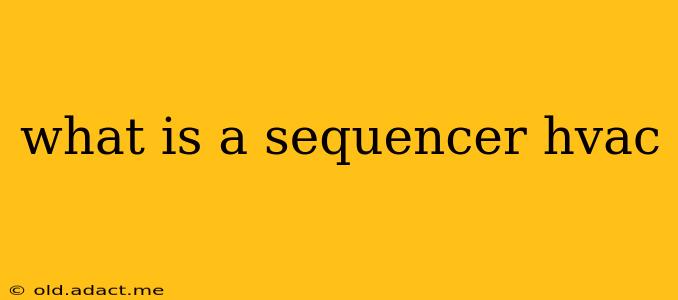An HVAC sequencer is a crucial component in larger HVAC systems, particularly those with multiple units or zones. Instead of simply turning all units on at once, a sequencer controls the startup and shutdown of these units in a specific order, optimizing system performance and energy efficiency. Think of it as a sophisticated traffic controller for your heating and cooling equipment. This intelligent management prevents overloading the electrical system, reduces strain on individual components, and allows for more precise temperature regulation.
How Does an HVAC Sequencer Work?
The core function of an HVAC sequencer is to stagger the operation of multiple units or zones. This prevents a sudden, significant surge in electrical demand, which can trip circuit breakers or cause voltage fluctuations. The sequencer uses a pre-programmed logic sequence to start and stop each unit one after another, typically with a short delay between each activation.
This sequencing logic can be customized to account for various factors, such as:
- System capacity: The sequencer considers the total cooling or heating capacity needed and activates units accordingly. If only a small amount of cooling is needed, only a single unit might be activated. If the demand is high, multiple units will be brought online sequentially.
- Temperature requirements: Based on setpoints and sensor feedback, the sequencer will decide which units to activate or deactivate to maintain optimal temperatures.
- Unit priorities: Some units might be designated as "lead" units, starting first and operating for longer durations. Others could be "secondary" units that only activate when the primary units can’t meet the demand.
- Preventive maintenance: The sequencer can also be programmed to rotate unit operation, ensuring even wear and tear across all components.
What are the Benefits of Using an HVAC Sequencer?
The advantages of incorporating an HVAC sequencer are numerous:
- Reduced electrical load: By staggering startup, sequencers significantly reduce the initial surge of electricity demand, minimizing the risk of overloading the electrical system.
- Improved energy efficiency: Sequencers optimize the use of HVAC units, ensuring only the necessary capacity is activated at any given time. This translates to lower energy consumption and reduced operating costs.
- Extended equipment life: Even wear and tear on multiple units due to staggered operation prolongs their lifespan.
- Enhanced temperature control: Precise temperature regulation is achieved through the sequential activation and deactivation of units based on real-time demands.
- Reduced noise levels: Staggering unit operation can often decrease the overall noise produced by the system.
What Types of HVAC Systems Use Sequencers?
HVAC sequencers are commonly found in larger commercial or industrial buildings, but they can also be employed in high-end residential systems with multiple zones or units. They are particularly valuable in:
- Multi-zone HVAC systems: Buildings with many climate-controlled zones benefit from sequencers that can manage individual zone requirements efficiently.
- Large-scale chillers: In large cooling systems, sequencers manage the operation of multiple chillers to optimize performance and minimize strain.
- HVAC systems with multiple air handling units (AHUs): Sequencers ensure the even distribution of load across multiple AHUs.
How Does an HVAC Sequencer Differ from a Simple Thermostat?
A standard thermostat simply turns the HVAC system on or off based on temperature readings. An HVAC sequencer, on the other hand, manages the operation of multiple units or zones, introducing a layer of sophisticated control to optimize energy use and system longevity. A thermostat is a single point of control, while a sequencer orchestrates the operation of a larger, more complex system.
Can I Install an HVAC Sequencer Myself?
Installing an HVAC sequencer is a complex task best left to qualified HVAC technicians. The system requires specialized knowledge and expertise to ensure proper wiring, programming, and integration with the existing HVAC equipment. Improper installation can lead to malfunction and potential safety hazards.
What are the potential problems with an HVAC sequencer?
While sequencers offer significant benefits, potential problems can arise:
- Programming errors: Incorrect programming can lead to inefficient operation or even damage to components.
- Component failure: As with any electrical equipment, sequencer components can fail over time, requiring repair or replacement.
- Compatibility issues: Ensuring compatibility between the sequencer and existing HVAC equipment is crucial.
By understanding the role and functionality of an HVAC sequencer, building owners and managers can make informed decisions about optimizing their HVAC systems for efficiency, longevity, and cost-effectiveness. Remember to always consult with qualified HVAC professionals for installation, maintenance, and troubleshooting.
